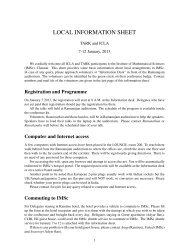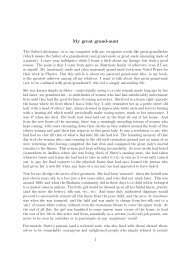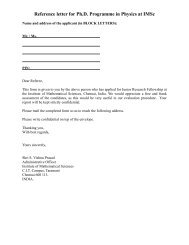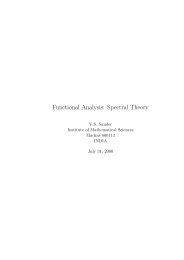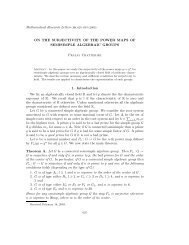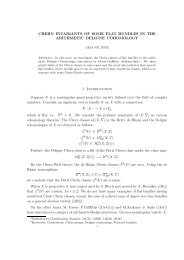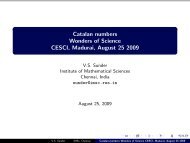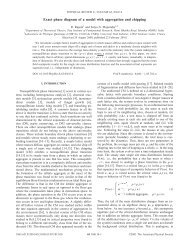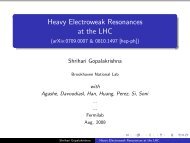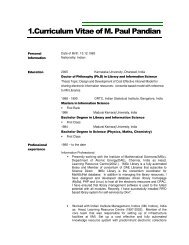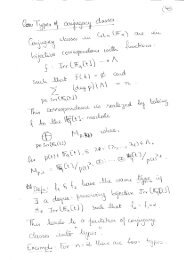Claus Koestler - The Institute of Mathematical Sciences
Claus Koestler - The Institute of Mathematical Sciences
Claus Koestler - The Institute of Mathematical Sciences
Create successful ePaper yourself
Turn your PDF publications into a flip-book with our unique Google optimized e-Paper software.
Symmetries and independence<br />
in noncommutative probability<br />
<strong>Claus</strong> Köstler<br />
<strong>Institute</strong> <strong>of</strong> Mathematics and Physics<br />
Aberystwyth University<br />
cck@aber.ac.uk<br />
ICM Satellite Conference on Operator Algebras<br />
<strong>The</strong> <strong>Institute</strong> <strong>of</strong> <strong>Mathematical</strong> <strong>Sciences</strong> (IMSc)<br />
Chennai<br />
August 10, 2010<br />
<strong>Claus</strong> Köstler<br />
Symmetries and independence
Motivation<br />
Though many probabilistic symmetries are conceivable [...], four <strong>of</strong><br />
them - stationarity, contractability, exchangeablity [and<br />
rotatability] - stand out as especially interesting and important in<br />
several ways: <strong>The</strong>ir study leads to some deep structural<br />
theorems <strong>of</strong> great beauty and significance [...].<br />
Olav Kallenberg (2005)<br />
<strong>Claus</strong> Köstler<br />
Symmetries and independence
Motivation<br />
Though many probabilistic symmetries are conceivable [...], four <strong>of</strong><br />
them - stationarity, contractability, exchangeablity [and<br />
rotatability] - stand out as especially interesting and important in<br />
several ways: <strong>The</strong>ir study leads to some deep structural<br />
theorems <strong>of</strong> great beauty and significance [...].<br />
Quest<br />
Olav Kallenberg (2005)<br />
• Transfer related concepts to noncommutative probability<br />
• Show that these concepts are fruitful in the study <strong>of</strong> operator<br />
algebras and quantum dynamics<br />
<strong>Claus</strong> Köstler<br />
Symmetries and independence
Motivation<br />
Though many probabilistic symmetries are conceivable [...], four <strong>of</strong><br />
them - stationarity, contractability, exchangeablity [and<br />
rotatability] - stand out as especially interesting and important in<br />
several ways: <strong>The</strong>ir study leads to some deep structural<br />
theorems <strong>of</strong> great beauty and significance [...].<br />
Quest<br />
Olav Kallenberg (2005)<br />
• Transfer related concepts to noncommutative probability<br />
• Show that these concepts are fruitful in the study <strong>of</strong> operator<br />
algebras and quantum dynamics<br />
Remark<br />
Noncommutative probability = classical & quantum probability<br />
<strong>Claus</strong> Köstler<br />
Symmetries and independence
Foundational result on distributional symmetries and<br />
invariance principles in classical probability<br />
<strong>The</strong> random variables (X n ) n≥0 are said to be exchangeable if<br />
E ( ) ( )<br />
X i(1) · · · X i(n) = E Xσ(i(1)) · · · X σ(i(n)) (σ ∈ S ∞ )<br />
for all n-tuples i: {1, 2, . . . , n} → N 0 and n ∈ N.<br />
<strong>Claus</strong> Köstler<br />
Symmetries and independence
Foundational result on distributional symmetries and<br />
invariance principles in classical probability<br />
<strong>The</strong> random variables (X n ) n≥0 are said to be exchangeable if<br />
E ( ) ( )<br />
X i(1) · · · X i(n) = E Xσ(i(1)) · · · X σ(i(n)) (σ ∈ S ∞ )<br />
for all n-tuples i: {1, 2, . . . , n} → N 0 and n ∈ N.<br />
<strong>The</strong>orem (De Finetti 1931,. . . )<br />
<strong>The</strong> law <strong>of</strong> an exchangeable sequence (X n ) n≥0 is given by a unique<br />
convex combination <strong>of</strong> infinite product measures.<br />
<strong>Claus</strong> Köstler<br />
Symmetries and independence
Foundational result on distributional symmetries and<br />
invariance principles in classical probability<br />
<strong>The</strong> random variables (X n ) n≥0 are said to be exchangeable if<br />
E ( ) ( )<br />
X i(1) · · · X i(n) = E Xσ(i(1)) · · · X σ(i(n)) (σ ∈ S ∞ )<br />
for all n-tuples i: {1, 2, . . . , n} → N 0 and n ∈ N.<br />
<strong>The</strong>orem (De Finetti 1931,. . . )<br />
<strong>The</strong> law <strong>of</strong> an exchangeable sequence (X n ) n≥0 is given by a unique<br />
convex combination <strong>of</strong> infinite product measures.<br />
”Any exchangeable process is an average <strong>of</strong> i.i.d. processes.”<br />
<strong>Claus</strong> Köstler<br />
Symmetries and independence
Foundational result on distributional symmetries and<br />
invariance principles in free probability<br />
Replacing permutation groups by Wang’s quantum permutation<br />
groups . . .<br />
<strong>The</strong>orem (K. & Speicher 2008)<br />
<strong>The</strong> following are equivalent for an infinite sequence <strong>of</strong> random<br />
variables x 1 , x 2 , . . . in a W*-algebraic probability space (A, ϕ):<br />
<strong>Claus</strong> Köstler<br />
Symmetries and independence
Foundational result on distributional symmetries and<br />
invariance principles in free probability<br />
Replacing permutation groups by Wang’s quantum permutation<br />
groups . . .<br />
<strong>The</strong>orem (K. & Speicher 2008)<br />
<strong>The</strong> following are equivalent for an infinite sequence <strong>of</strong> random<br />
variables x 1 , x 2 , . . . in a W*-algebraic probability space (A, ϕ):<br />
(a) the sequence is quantum exchangeable<br />
<strong>Claus</strong> Köstler<br />
Symmetries and independence
Foundational result on distributional symmetries and<br />
invariance principles in free probability<br />
Replacing permutation groups by Wang’s quantum permutation<br />
groups . . .<br />
<strong>The</strong>orem (K. & Speicher 2008)<br />
<strong>The</strong> following are equivalent for an infinite sequence <strong>of</strong> random<br />
variables x 1 , x 2 , . . . in a W*-algebraic probability space (A, ϕ):<br />
(a) the sequence is quantum exchangeable<br />
(b) the sequence is identically distributed and freely<br />
independent with amalgamation over T<br />
Here T denotes the tail algebra T = ⋂ n∈N vN(x k|k ≥ n).<br />
<strong>Claus</strong> Köstler<br />
Symmetries and independence
Foundational result on distributional symmetries and<br />
invariance principles in free probability<br />
Replacing permutation groups by Wang’s quantum permutation<br />
groups . . .<br />
<strong>The</strong>orem (K. & Speicher 2008)<br />
<strong>The</strong> following are equivalent for an infinite sequence <strong>of</strong> random<br />
variables x 1 , x 2 , . . . in a W*-algebraic probability space (A, ϕ):<br />
(a) the sequence is quantum exchangeable<br />
(b) the sequence is identically distributed and freely<br />
independent with amalgamation over T<br />
Here T denotes the tail algebra T = ⋂ n∈N vN(x k|k ≥ n).<br />
<strong>Claus</strong> Köstler<br />
Symmetries and independence
Foundational result on distributional symmetries and<br />
invariance principles in free probability<br />
Replacing permutation groups by Wang’s quantum permutation<br />
groups . . .<br />
<strong>The</strong>orem (K. & Speicher 2008)<br />
<strong>The</strong> following are equivalent for an infinite sequence <strong>of</strong> random<br />
variables x 1 , x 2 , . . . in a W*-algebraic probability space (A, ϕ):<br />
(a) the sequence is quantum exchangeable<br />
(b) the sequence is identically distributed and freely<br />
independent with amalgamation over T<br />
(c) the sequence canonically embeds into ⋆ N T vN(x 1, T ), a von<br />
Neumann algebraic amalgamated free product over T<br />
Here T denotes the tail algebra T = ⋂ n∈N vN(x k|k ≥ n).<br />
<strong>Claus</strong> Köstler<br />
Symmetries and independence
Foundational result on distributional symmetries and<br />
invariance principles in free probability<br />
Replacing permutation groups by Wang’s quantum permutation<br />
groups . . .<br />
<strong>The</strong>orem (K. & Speicher 2008)<br />
<strong>The</strong> following are equivalent for an infinite sequence <strong>of</strong> random<br />
variables x 1 , x 2 , . . . in a W*-algebraic probability space (A, ϕ):<br />
(a) the sequence is quantum exchangeable<br />
(b) the sequence is identically distributed and freely<br />
independent with amalgamation over T<br />
(c) the sequence canonically embeds into ⋆ N T vN(x 1, T ), a von<br />
Neumann algebraic amalgamated free product over T<br />
Here T denotes the tail algebra T = ⋂ n∈N vN(x k|k ≥ n).<br />
See talks <strong>of</strong> Curran and Speicher for more recent developments.<br />
<strong>Claus</strong> Köstler<br />
Symmetries and independence
Foundational result on the representation theory<br />
<strong>of</strong> the infinite symmetric group S ∞<br />
S ∞ is the inductive limit <strong>of</strong> the symmetric group S n as n → ∞,<br />
acting on {0, 1, 2, . . .}. A function χ: S ∞ → C is a character if it<br />
is constant on conjugacy classes, positive definite and normalized<br />
at the unity.<br />
<strong>Claus</strong> Köstler<br />
Symmetries and independence
Foundational result on the representation theory<br />
<strong>of</strong> the infinite symmetric group S ∞<br />
S ∞ is the inductive limit <strong>of</strong> the symmetric group S n as n → ∞,<br />
acting on {0, 1, 2, . . .}. A function χ: S ∞ → C is a character if it<br />
is constant on conjugacy classes, positive definite and normalized<br />
at the unity.<br />
Elementary observation<br />
Let γ i := (0, i). <strong>The</strong>n the sequence (γ i ) i∈N is exchangeable, i.e.<br />
χ ( γ i(1) γ i(2) · · · γ i(n)<br />
)<br />
= χ<br />
(<br />
γσ(i(1)) γ σ(i(2)) · · · γ σ(i(n))<br />
)<br />
for σ ∈ S ∞ with σ(0) = 0, n-tuples i: {1, . . . , n} → N and n ∈ N.<br />
<strong>Claus</strong> Köstler<br />
Symmetries and independence
Foundational result on the representation theory<br />
<strong>of</strong> the infinite symmetric group S ∞<br />
S ∞ is the inductive limit <strong>of</strong> the symmetric group S n as n → ∞,<br />
acting on {0, 1, 2, . . .}. A function χ: S ∞ → C is a character if it<br />
is constant on conjugacy classes, positive definite and normalized<br />
at the unity.<br />
Elementary observation<br />
Let γ i := (0, i). <strong>The</strong>n the sequence (γ i ) i∈N is exchangeable, i.e.<br />
χ ( γ i(1) γ i(2) · · · γ i(n)<br />
)<br />
= χ<br />
(<br />
γσ(i(1)) γ σ(i(2)) · · · γ σ(i(n))<br />
)<br />
for σ ∈ S ∞ with σ(0) = 0, n-tuples i: {1, . . . , n} → N and n ∈ N.<br />
Task<br />
Identify the convex combination <strong>of</strong> extremal characters <strong>of</strong> S ∞ . In<br />
other words: prove a noncommutative de Finetti theorem!<br />
<strong>Claus</strong> Köstler<br />
Symmetries and independence
Thoma’s theorem as a noncommutative de Finetti theorem<br />
<strong>The</strong>orem (Thoma 1964)<br />
An extremal character <strong>of</strong> the group S ∞ is <strong>of</strong> the form<br />
χ(σ) =<br />
⎛<br />
∞∏ ∞∑<br />
∑<br />
∞<br />
⎝ ai k + (−1) k−1<br />
k=2<br />
i=1<br />
j=1<br />
b k j<br />
⎞<br />
⎠<br />
m k (σ)<br />
Here m k (σ) is the number <strong>of</strong> k-cycles in the permutation σ and<br />
the two sequences (a i ) ∞ i=1 , (b j) ∞ j=1 satisfy<br />
∞∑ ∞∑<br />
a 1 ≥ a 2 ≥ · · · ≥ 0, b 1 ≥ b 2 ≥ · · · ≥ 0, a i + b j ≤ 1.<br />
i=1<br />
Alternative pro<strong>of</strong>s<br />
Vershik & Kerov 1981: asymptotic representation theory<br />
Okounkov 1997: Olshanski semigroups and spectral theory<br />
Gohm & K. 2010: operator algebraic pro<strong>of</strong> (see next talk)<br />
<strong>Claus</strong> Köstler<br />
Symmetries and independence<br />
.<br />
j=1
Towards a braided version <strong>of</strong> Thoma’s theorem<br />
<strong>The</strong> Hecke algebra H q (∞) over C with parameter q ∈ C is the<br />
unital algebra with generators g 0 , g 1 , . . . and relations<br />
g 2 n = (q − 1)g n + q;<br />
g m g n = g n g m if | n − m |≥ 2;<br />
g n g n+1 g n = g n+1 g n g n+1 .<br />
<strong>Claus</strong> Köstler<br />
Symmetries and independence
Towards a braided version <strong>of</strong> Thoma’s theorem<br />
<strong>The</strong> Hecke algebra H q (∞) over C with parameter q ∈ C is the<br />
unital algebra with generators g 0 , g 1 , . . . and relations<br />
g 2 n = (q − 1)g n + q;<br />
g m g n = g n g m if | n − m |≥ 2;<br />
g n g n+1 g n = g n+1 g n g n+1 .<br />
If q is a root <strong>of</strong> unity there exists an involution and a trace on<br />
H q (∞) such that the g n are unitary.<br />
<strong>Claus</strong> Köstler<br />
Symmetries and independence
Towards a braided version <strong>of</strong> Thoma’s theorem<br />
<strong>The</strong> Hecke algebra H q (∞) over C with parameter q ∈ C is the<br />
unital algebra with generators g 0 , g 1 , . . . and relations<br />
g 2 n = (q − 1)g n + q;<br />
g m g n = g n g m if | n − m |≥ 2;<br />
g n g n+1 g n = g n+1 g n g n+1 .<br />
If q is a root <strong>of</strong> unity there exists an involution and a trace on<br />
H q (∞) such that the g n are unitary. Now let<br />
γ 1 := g 1 ,<br />
γ n := g 1 g 2 · · · g n−1 g n gn−1 −1 · · · g 2 −1 g 1<br />
−1<br />
<strong>Claus</strong> Köstler<br />
Symmetries and independence
Towards a braided version <strong>of</strong> Thoma’s theorem<br />
<strong>The</strong> Hecke algebra H q (∞) over C with parameter q ∈ C is the<br />
unital algebra with generators g 0 , g 1 , . . . and relations<br />
g 2 n = (q − 1)g n + q;<br />
g m g n = g n g m if | n − m |≥ 2;<br />
g n g n+1 g n = g n+1 g n g n+1 .<br />
If q is a root <strong>of</strong> unity there exists an involution and a trace on<br />
H q (∞) such that the g n are unitary. Now let<br />
γ 1 := g 1 ,<br />
γ n := g 1 g 2 · · · g n−1 g n gn−1 −1 · · · g 2 −1 g 1<br />
−1<br />
Replacing the role <strong>of</strong> S ∞ by the braid group B ∞ turns<br />
exchangeability into braidability....<br />
<strong>The</strong>orem (Gohm & K.)<br />
<strong>The</strong> sequence (γ n ) n∈N is braidable.<br />
This will become more clear later . . . see talk <strong>of</strong> Gohm<br />
<strong>Claus</strong> Köstler<br />
Symmetries and independence
Noncommutative random variables<br />
A (noncommutative) probability space (A, ϕ) is a von Neumann<br />
algebra A (with separable predual) equipped with a faithful normal<br />
state ϕ.<br />
A random variable ι: (A 0 , ϕ 0 ) → (A, ϕ) is is an injective<br />
*-homomorphism from A 0 into A such that ϕ 0 = ϕ ◦ ι and the<br />
ϕ-preserving conditional expectation from A onto ι(A 0 ) exists.<br />
Given the sequence <strong>of</strong> random variables<br />
(ι n ) n≥0 : (A 0 , ϕ 0 ) → (A, ϕ),<br />
fix some a ∈ A 0 . <strong>The</strong>n x n := ι n (a) defines the operators<br />
x 0 , x 1 , x 2 , . . . (now random variables in the operator sense).<br />
<strong>Claus</strong> Köstler<br />
Symmetries and independence
Noncommutative distributions<br />
Two sequences <strong>of</strong> random variables (ι n ) n≥0 and<br />
(˜ι n ) n≥0 : (A 0 , ϕ 0 ) → (A, ϕ) have the same distribution if<br />
ϕ ( ι i(1) (a 1 )ι i(2) (a 2 ) · · · ι i(n) (a n ) ) = ϕ (˜ι i(1) (a 1 ) ˜ι i(2) (a 2 ) · · · ˜ι i(n) (a n ) )<br />
for all n-tuples i: {1, 2, . . . , n} → N 0 , (a 1 , . . . , a n ) ∈ A n 0<br />
and n ∈ N.<br />
<strong>Claus</strong> Köstler<br />
Symmetries and independence
Noncommutative distributions<br />
Two sequences <strong>of</strong> random variables (ι n ) n≥0 and<br />
(˜ι n ) n≥0 : (A 0 , ϕ 0 ) → (A, ϕ) have the same distribution if<br />
ϕ ( ι i(1) (a 1 )ι i(2) (a 2 ) · · · ι i(n) (a n ) ) = ϕ (˜ι i(1) (a 1 ) ˜ι i(2) (a 2 ) · · · ˜ι i(n) (a n ) )<br />
for all n-tuples i: {1, 2, . . . , n} → N 0 , (a 1 , . . . , a n ) ∈ A n 0<br />
and n ∈ N.<br />
Notation<br />
(ι 0 , ι 1 , ι 2 , . . .) distr = (˜ι 0 , ˜ι 1 , ˜ι 2 , . . .)<br />
<strong>Claus</strong> Köstler<br />
Symmetries and independence
Noncommutative distributional symmetries<br />
Just as in the classical case we can now talk about distributional<br />
symmetries. A sequence (x n ) n≥0 is<br />
• exchangeable if (ι 0 , ι 1 , ι 2 , . . .) distr = (ι π(0) , ι π(1) , ι π(2) , . . .) for<br />
any (finite) permutation π ∈ S ∞ <strong>of</strong> N 0 .<br />
<strong>Claus</strong> Köstler<br />
Symmetries and independence
Noncommutative distributional symmetries<br />
Just as in the classical case we can now talk about distributional<br />
symmetries. A sequence (x n ) n≥0 is<br />
• exchangeable if (ι 0 , ι 1 , ι 2 , . . .) distr = (ι π(0) , ι π(1) , ι π(2) , . . .) for<br />
any (finite) permutation π ∈ S ∞ <strong>of</strong> N 0 .<br />
• spreadable if (ι 0 , ι 1 , ι 2 , . . .) distr = (ι n0 , ι n1 , ι n2 , . . .) for any<br />
subsequence (n 0 , n 1 , n 2 , . . .) <strong>of</strong> (0, 1, 2, . . .).<br />
<strong>Claus</strong> Köstler<br />
Symmetries and independence
Noncommutative distributional symmetries<br />
Just as in the classical case we can now talk about distributional<br />
symmetries. A sequence (x n ) n≥0 is<br />
• exchangeable if (ι 0 , ι 1 , ι 2 , . . .) distr = (ι π(0) , ι π(1) , ι π(2) , . . .) for<br />
any (finite) permutation π ∈ S ∞ <strong>of</strong> N 0 .<br />
• spreadable if (ι 0 , ι 1 , ι 2 , . . .) distr = (ι n0 , ι n1 , ι n2 , . . .) for any<br />
subsequence (n 0 , n 1 , n 2 , . . .) <strong>of</strong> (0, 1, 2, . . .).<br />
• stationary if (ι 0 , ι 1 , ι 2 , . . .) distr = (ι k , ι k+1 , ι k+2 , . . .) for all<br />
k ∈ N.<br />
<strong>Claus</strong> Köstler<br />
Symmetries and independence
Noncommutative distributional symmetries<br />
Just as in the classical case we can now talk about distributional<br />
symmetries. A sequence (x n ) n≥0 is<br />
• exchangeable if (ι 0 , ι 1 , ι 2 , . . .) distr = (ι π(0) , ι π(1) , ι π(2) , . . .) for<br />
any (finite) permutation π ∈ S ∞ <strong>of</strong> N 0 .<br />
• spreadable if (ι 0 , ι 1 , ι 2 , . . .) distr = (ι n0 , ι n1 , ι n2 , . . .) for any<br />
subsequence (n 0 , n 1 , n 2 , . . .) <strong>of</strong> (0, 1, 2, . . .).<br />
• stationary if (ι 0 , ι 1 , ι 2 , . . .) distr = (ι k , ι k+1 , ι k+2 , . . .) for all<br />
k ∈ N.<br />
<strong>Claus</strong> Köstler<br />
Symmetries and independence
Noncommutative distributional symmetries<br />
Just as in the classical case we can now talk about distributional<br />
symmetries. A sequence (x n ) n≥0 is<br />
• exchangeable if (ι 0 , ι 1 , ι 2 , . . .) distr = (ι π(0) , ι π(1) , ι π(2) , . . .) for<br />
any (finite) permutation π ∈ S ∞ <strong>of</strong> N 0 .<br />
• spreadable if (ι 0 , ι 1 , ι 2 , . . .) distr = (ι n0 , ι n1 , ι n2 , . . .) for any<br />
subsequence (n 0 , n 1 , n 2 , . . .) <strong>of</strong> (0, 1, 2, . . .).<br />
• stationary if (ι 0 , ι 1 , ι 2 , . . .) distr = (ι k , ι k+1 , ι k+2 , . . .) for all<br />
k ∈ N.<br />
Lemma (Hierarchy <strong>of</strong> distributional symmetries)<br />
exchangeability ⇒ spreadability ⇒ stationarity ⇒ identical distr.<br />
<strong>Claus</strong> Köstler<br />
Symmetries and independence
Noncommutative conditional independence<br />
Let A 0 , A 1 , A 2 be three von Neumann subalgebras <strong>of</strong> A with<br />
ϕ-preserving conditional expectations E i : A → A i (i = 0, 1, 2).<br />
<strong>Claus</strong> Köstler<br />
Symmetries and independence
Noncommutative conditional independence<br />
Let A 0 , A 1 , A 2 be three von Neumann subalgebras <strong>of</strong> A with<br />
ϕ-preserving conditional expectations E i : A → A i (i = 0, 1, 2).<br />
Definition<br />
A 1 and A 2 are A 0 -independent if<br />
E 0 (xy) = E 0 (x)E 0 (y) (x ∈ A 0 ∨ A 1 , y ∈ A 0 ∨ A 2 )<br />
<strong>Claus</strong> Köstler<br />
Symmetries and independence
Noncommutative conditional independence<br />
Let A 0 , A 1 , A 2 be three von Neumann subalgebras <strong>of</strong> A with<br />
ϕ-preserving conditional expectations E i : A → A i (i = 0, 1, 2).<br />
Definition<br />
A 1 and A 2 are A 0 -independent if<br />
Remarks<br />
E 0 (xy) = E 0 (x)E 0 (y) (x ∈ A 0 ∨ A 1 , y ∈ A 0 ∨ A 2 )<br />
• A 0 ⊂ A 0 ∨ A 1 , A 0 ∨ A 2 ⊂ A is a commuting square<br />
• A 0 ≃ C: Kümmerer’s notion <strong>of</strong> n.c. independence<br />
• A = L ∞ (Ω, Σ, µ): cond. independence w.r.t. sub-σ-algebra<br />
<strong>Claus</strong> Köstler<br />
Symmetries and independence
Noncommutative conditional independence<br />
Let A 0 , A 1 , A 2 be three von Neumann subalgebras <strong>of</strong> A with<br />
ϕ-preserving conditional expectations E i : A → A i (i = 0, 1, 2).<br />
Definition<br />
A 1 and A 2 are A 0 -independent if<br />
Remarks<br />
E 0 (xy) = E 0 (x)E 0 (y) (x ∈ A 0 ∨ A 1 , y ∈ A 0 ∨ A 2 )<br />
• A 0 ⊂ A 0 ∨ A 1 , A 0 ∨ A 2 ⊂ A is a commuting square<br />
• A 0 ≃ C: Kümmerer’s notion <strong>of</strong> n.c. independence<br />
• A = L ∞ (Ω, Σ, µ): cond. independence w.r.t. sub-σ-algebra<br />
• Many different forms <strong>of</strong> noncommutative independence!<br />
<strong>Claus</strong> Köstler<br />
Symmetries and independence
Noncommutative conditional independence<br />
Let A 0 , A 1 , A 2 be three von Neumann subalgebras <strong>of</strong> A with<br />
ϕ-preserving conditional expectations E i : A → A i (i = 0, 1, 2).<br />
Definition<br />
A 1 and A 2 are A 0 -independent if<br />
Remarks<br />
E 0 (xy) = E 0 (x)E 0 (y) (x ∈ A 0 ∨ A 1 , y ∈ A 0 ∨ A 2 )<br />
• A 0 ⊂ A 0 ∨ A 1 , A 0 ∨ A 2 ⊂ A is a commuting square<br />
• A 0 ≃ C: Kümmerer’s notion <strong>of</strong> n.c. independence<br />
• A = L ∞ (Ω, Σ, µ): cond. independence w.r.t. sub-σ-algebra<br />
• Many different forms <strong>of</strong> noncommutative independence!<br />
• C-independence & Speicher’s universality rules<br />
tensor independence or free independence<br />
<strong>Claus</strong> Köstler<br />
Symmetries and independence
Conditional independence <strong>of</strong> sequences<br />
A sequence <strong>of</strong> random variables (ι n ) n∈N0 : (A 0 , ϕ 0 ) → (A, ϕ) is<br />
(full) B-independent if<br />
∨<br />
{ιi (A 0 ) | i ∈ I } ∨ B<br />
and<br />
∨<br />
{ιj (A 0 ) | j ∈ J} ∨ B<br />
are B-independent whenever I ∩ J = ∅ with I , J ⊂ N 0 .<br />
<strong>Claus</strong> Köstler<br />
Symmetries and independence
Conditional independence <strong>of</strong> sequences<br />
A sequence <strong>of</strong> random variables (ι n ) n∈N0 : (A 0 , ϕ 0 ) → (A, ϕ) is<br />
(full) B-independent if<br />
∨<br />
{ιi (A 0 ) | i ∈ I } ∨ B<br />
and<br />
∨<br />
{ιj (A 0 ) | j ∈ J} ∨ B<br />
are B-independent whenever I ∩ J = ∅ with I , J ⊂ N 0 .<br />
Remark<br />
Many interesting notions are possible for sequences:<br />
1. conditional top-order independence<br />
2. conditional order independence<br />
3. conditional full independence<br />
4. discrete noncommutative random measure factorizations<br />
<strong>Claus</strong> Köstler<br />
Symmetries and independence
Noncommutative extended De Finetti theorem<br />
Let (ι n ) n≥0 be random variables as before with tail algebra<br />
A tail := ⋂ ∨<br />
{ι k (A 0 )},<br />
n≥0 k≥n<br />
and consider:<br />
(a) (ι n ) n≥0 is exchangeable<br />
(c) (ι n ) n≥0 is spreadable<br />
(d) (ι n ) n≥0 is stationary and A tail -independent<br />
(e) (ι n ) n≥0 is identically distributed and A tail -independent<br />
<strong>Claus</strong> Köstler<br />
Symmetries and independence
Noncommutative extended De Finetti theorem<br />
Let (ι n ) n≥0 be random variables as before with tail algebra<br />
A tail := ⋂ ∨<br />
{ι k (A 0 )},<br />
n≥0 k≥n<br />
and consider:<br />
(a) (ι n ) n≥0 is exchangeable<br />
(c) (ι n ) n≥0 is spreadable<br />
(d) (ι n ) n≥0 is stationary and A tail -independent<br />
(e) (ι n ) n≥0 is identically distributed and A tail -independent<br />
<strong>The</strong>orem (K. ’07-’08 )<br />
(a) ⇒ (c) ⇒ (d) ⇒ (e),<br />
<strong>Claus</strong> Köstler<br />
Symmetries and independence
Noncommutative extended De Finetti theorem<br />
Let (ι n ) n≥0 be random variables as before with tail algebra<br />
A tail := ⋂ ∨<br />
{ι k (A 0 )},<br />
n≥0 k≥n<br />
and consider:<br />
(a) (ι n ) n≥0 is exchangeable<br />
(c) (ι n ) n≥0 is spreadable<br />
(d) (ι n ) n≥0 is stationary and A tail -independent<br />
(e) (ι n ) n≥0 is identically distributed and A tail -independent<br />
<strong>The</strong>orem (K. ’07-’08, Gohm & K. ’08)<br />
(a) ⇒ (c) ⇒ (d) ⇒ (e),<br />
but (a) ⇍ (c) ⇍ (d) ⇍ (e)<br />
<strong>Claus</strong> Köstler<br />
Symmetries and independence
Noncommutative extended De Finetti theorem<br />
Let (ι n ) n≥0 be random variables as before with tail algebra<br />
A tail := ⋂ ∨<br />
{ι k (A 0 )},<br />
n≥0 k≥n<br />
and consider:<br />
(a) (ι n ) n≥0 is exchangeable<br />
(c) (ι n ) n≥0 is spreadable<br />
(d) (ι n ) n≥0 is stationary and A tail -independent<br />
(e) (ι n ) n≥0 is identically distributed and A tail -independent<br />
<strong>The</strong>orem (K. ’07-’08, Gohm & K. ’08)<br />
(a) ⇒ (c) ⇒ (d) ⇒ (e),<br />
but (a) ⇍ (c) ⇍ (d) ⇍ (e)<br />
Remark<br />
(a) to (e) are equivalent if the operators x n mutually commute.<br />
[De Finetti ’31, Ryll-Nardzewski ’57,. . . , Størmer ’69,... Hudson<br />
’76, ... Petz ’89,. . . , Accardi&Lu ’93, . . . ]<br />
<strong>Claus</strong> Köstler<br />
Symmetries and independence
An ingredient for proving full cond. independence<br />
Localization Preserving Mean Ergodic <strong>The</strong>orem (K ’08)<br />
Let (M, ψ) be a probability space and suppose {α N } N∈N0 is a<br />
family <strong>of</strong> ψ-preserving completely positive linear maps <strong>of</strong> M<br />
satisfying<br />
1. M α N<br />
⊂ M α N+1<br />
for all N ∈ N 0 ;<br />
2. M = ∨ N∈N 0<br />
M α N<br />
.<br />
Further let<br />
M (n)<br />
N<br />
:= 1 ∑n−1<br />
αN k and T N := ⃗∏ N<br />
n<br />
k=0<br />
l=0 αlN l<br />
M (N)<br />
l<br />
.<br />
<strong>The</strong>n we have<br />
for any x ∈ M.<br />
sot- lim<br />
N→∞ T N(x) = E M α 0 (x)<br />
<strong>Claus</strong> Köstler<br />
Symmetries and independence
Discussion<br />
• Noncommutative conditional independence emerges from<br />
distributional symmetries in terms <strong>of</strong> commuting squares<br />
For further details see:<br />
C. Köstler. A noncommutative extended de Finetti theorem. J. Funct. Anal.<br />
258, 1073-1120 (2010)<br />
<strong>Claus</strong> Köstler<br />
Symmetries and independence
Discussion<br />
• Noncommutative conditional independence emerges from<br />
distributional symmetries in terms <strong>of</strong> commuting squares<br />
• Exchangeability is too weak to identify the structure <strong>of</strong> the<br />
underlying noncommutative probability space<br />
For further details see:<br />
C. Köstler. A noncommutative extended de Finetti theorem. J. Funct. Anal.<br />
258, 1073-1120 (2010)<br />
<strong>Claus</strong> Köstler<br />
Symmetries and independence
Discussion<br />
• Noncommutative conditional independence emerges from<br />
distributional symmetries in terms <strong>of</strong> commuting squares<br />
• Exchangeability is too weak to identify the structure <strong>of</strong> the<br />
underlying noncommutative probability space<br />
• All reverse implications in the noncommutative extended de<br />
Finetti theorem fail due to deep structural reasons!<br />
For further details see:<br />
C. Köstler. A noncommutative extended de Finetti theorem. J. Funct. Anal.<br />
258, 1073-1120 (2010)<br />
<strong>Claus</strong> Köstler<br />
Symmetries and independence
Discussion<br />
• Noncommutative conditional independence emerges from<br />
distributional symmetries in terms <strong>of</strong> commuting squares<br />
• Exchangeability is too weak to identify the structure <strong>of</strong> the<br />
underlying noncommutative probability space<br />
• All reverse implications in the noncommutative extended de<br />
Finetti theorem fail due to deep structural reasons!<br />
• This will become clear from braidability...<br />
For further details see:<br />
C. Köstler. A noncommutative extended de Finetti theorem. J. Funct. Anal.<br />
258, 1073-1120 (2010)<br />
R. Gohm & C. Köstler. Noncommutative independence from the braid group<br />
B ∞. Commun. Math. Phys. 289, 435–482 (2009)<br />
<strong>Claus</strong> Köstler<br />
Symmetries and independence
Artin braid groups B n<br />
Algebraic Definition (Artin 1925)<br />
B n is presented by n − 1 generators σ 1 , . . . , σ n−1 satisfying<br />
σ i σ j σ i = σ j σ i σ j if | i − j | = 1 (B1)<br />
σ i σ j = σ j σ i if | i − j | > 1 (B2)<br />
0 1 i-1 i<br />
♣ ♣ ♣<br />
♣ ♣ ♣<br />
0 1 i-1 i<br />
♣ ♣ ♣<br />
♣ ♣ ♣<br />
Figure: Artin generators σ i (left) and σ −1<br />
i<br />
(right)<br />
B 1 ⊂ B 2 ⊂ B 3 ⊂ . . . ⊂ B ∞ (inductive limit)<br />
<strong>Claus</strong> Köstler<br />
Symmetries and independence
Braidability<br />
Definition (Gohm & K. ’08)<br />
A sequence (ι n ) n≥0 : (A 0 , ϕ 0 ) → (A, ϕ) is braidable if there exists<br />
a representation ρ: B ∞ → Aut(A, ϕ) satisfying:<br />
ι n = ρ(σ n σ n−1 · · · σ 1 )ι 0 for all n ≥ 1;<br />
ι 0 = ρ(σ n )ι 0 if n ≥ 2.<br />
<strong>Claus</strong> Köstler<br />
Symmetries and independence
Braidability<br />
Definition (Gohm & K. ’08)<br />
A sequence (ι n ) n≥0 : (A 0 , ϕ 0 ) → (A, ϕ) is braidable if there exists<br />
a representation ρ: B ∞ → Aut(A, ϕ) satisfying:<br />
ι n = ρ(σ n σ n−1 · · · σ 1 )ι 0 for all n ≥ 1;<br />
ι 0 = ρ(σ n )ι 0 if n ≥ 2.<br />
Braidability extends exchangeability<br />
• If ρ(σ 2 n) = id for all n, one has a representation <strong>of</strong> S ∞ .<br />
<strong>Claus</strong> Köstler<br />
Symmetries and independence
Braidability<br />
Definition (Gohm & K. ’08)<br />
A sequence (ι n ) n≥0 : (A 0 , ϕ 0 ) → (A, ϕ) is braidable if there exists<br />
a representation ρ: B ∞ → Aut(A, ϕ) satisfying:<br />
ι n = ρ(σ n σ n−1 · · · σ 1 )ι 0 for all n ≥ 1;<br />
ι 0 = ρ(σ n )ι 0 if n ≥ 2.<br />
Braidability extends exchangeability<br />
• If ρ(σn) 2 = id for all n, one has a representation <strong>of</strong> S ∞ .<br />
{ (ιn )<br />
• (ι n ) n≥0 is exchangeable ⇔ n≥0 is braidable and<br />
ρ(σn) 2 = id for all n.<br />
<strong>Claus</strong> Köstler<br />
Symmetries and independence
Braidability implies spreadability<br />
Consider the conditions:<br />
(a) (x n ) n≥0 is exchangeable<br />
(b) (x n ) n≥0 is braidable<br />
(c) (x n ) n≥0 is spreadable<br />
(d) (x n ) n≥0 is stationary and A tail -independent<br />
<strong>Claus</strong> Köstler<br />
Symmetries and independence
Braidability implies spreadability<br />
Consider the conditions:<br />
(a) (x n ) n≥0 is exchangeable<br />
(b) (x n ) n≥0 is braidable<br />
(c) (x n ) n≥0 is spreadable<br />
(d) (x n ) n≥0 is stationary and A tail -independent<br />
<strong>The</strong>orem (Gohm & K. ’08)<br />
(a) ⇒ (b) ⇒ (c) ⇒ (d),<br />
but (a) ⇍ (b) ⇍ (d)<br />
<strong>Claus</strong> Köstler<br />
Symmetries and independence
Braidability implies spreadability<br />
Consider the conditions:<br />
(a) (x n ) n≥0 is exchangeable<br />
(b) (x n ) n≥0 is braidable<br />
(c) (x n ) n≥0 is spreadable<br />
(d) (x n ) n≥0 is stationary and A tail -independent<br />
<strong>The</strong>orem (Gohm & K. ’08)<br />
(a) ⇒ (b) ⇒ (c) ⇒ (d),<br />
but (a) ⇍ (b) ⇍ (d)<br />
Observation<br />
Large and interesting class <strong>of</strong> spreadable sequences is obtained<br />
from braidability.<br />
<strong>Claus</strong> Köstler<br />
Symmetries and independence
Remarks<br />
<strong>The</strong>re are many examples <strong>of</strong> braidability!<br />
• subfactor inclusion with small Jones index<br />
(’Jones-Temperley-Lieb algebras and Hecke algebras’)<br />
• left regular representation <strong>of</strong> B ∞<br />
• vertex models in quantum statistical physics (‘Yang-Baxter<br />
equations’)<br />
• . . .<br />
• representations <strong>of</strong> the symmetric group S ∞<br />
For further details see next talk by Gohm and:<br />
R. Gohm & C. Köstler. Noncommutative independence from the braid group<br />
B ∞. Commun. Math. Phys. 289, 435–482 (2009)<br />
<strong>Claus</strong> Köstler<br />
Symmetries and independence
References<br />
C. Köstler. A noncommutative extended de Finetti theorem. J. Funct. Anal.<br />
258, 1073-1120 (2010)<br />
(electronic: arXiv:0806.3621v1)<br />
R. Gohm & C. Köstler. Noncommutative independence from the braid group<br />
B ∞. Commun. Math. Phys. 289, 435–482 (2009)<br />
(electronic: arXiv:0806.3691v2)<br />
C. Köstler & R. Speicher. A noncommutative de Finetti theorem: Invariance<br />
under quantum permutations is equivalent to freeness with amalgamation.<br />
Commun. Math. Phys. 291(2), 473–490 (2009)<br />
(electronic: arXiv:0807.0677v1)<br />
C. Köstler. On Lehner’s ‘free’ noncommutative analogue <strong>of</strong> de Finetti’s<br />
theorem. 11 pages. To appear in Proc. Amer. Math. Soc.<br />
(electronic: arXiv:0806.3632v1)<br />
R. Gohm & C. Köstler. Noncommutative independence from characters <strong>of</strong> the<br />
symmetric group S ∞. 47 pages. Preprint (2010).<br />
(electronic: arXiv:1005.5726)<br />
<strong>Claus</strong> Köstler<br />
Symmetries and independence



